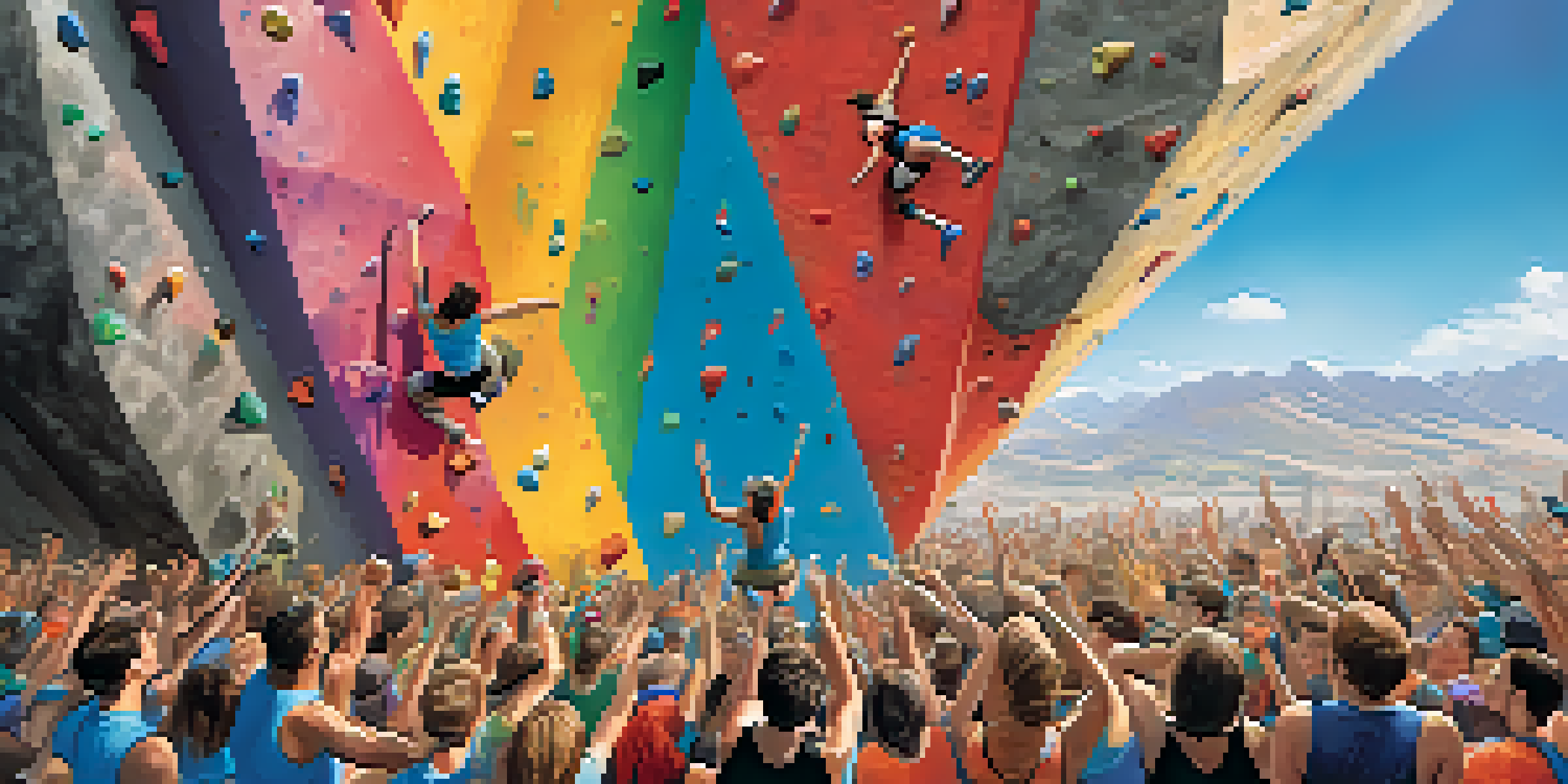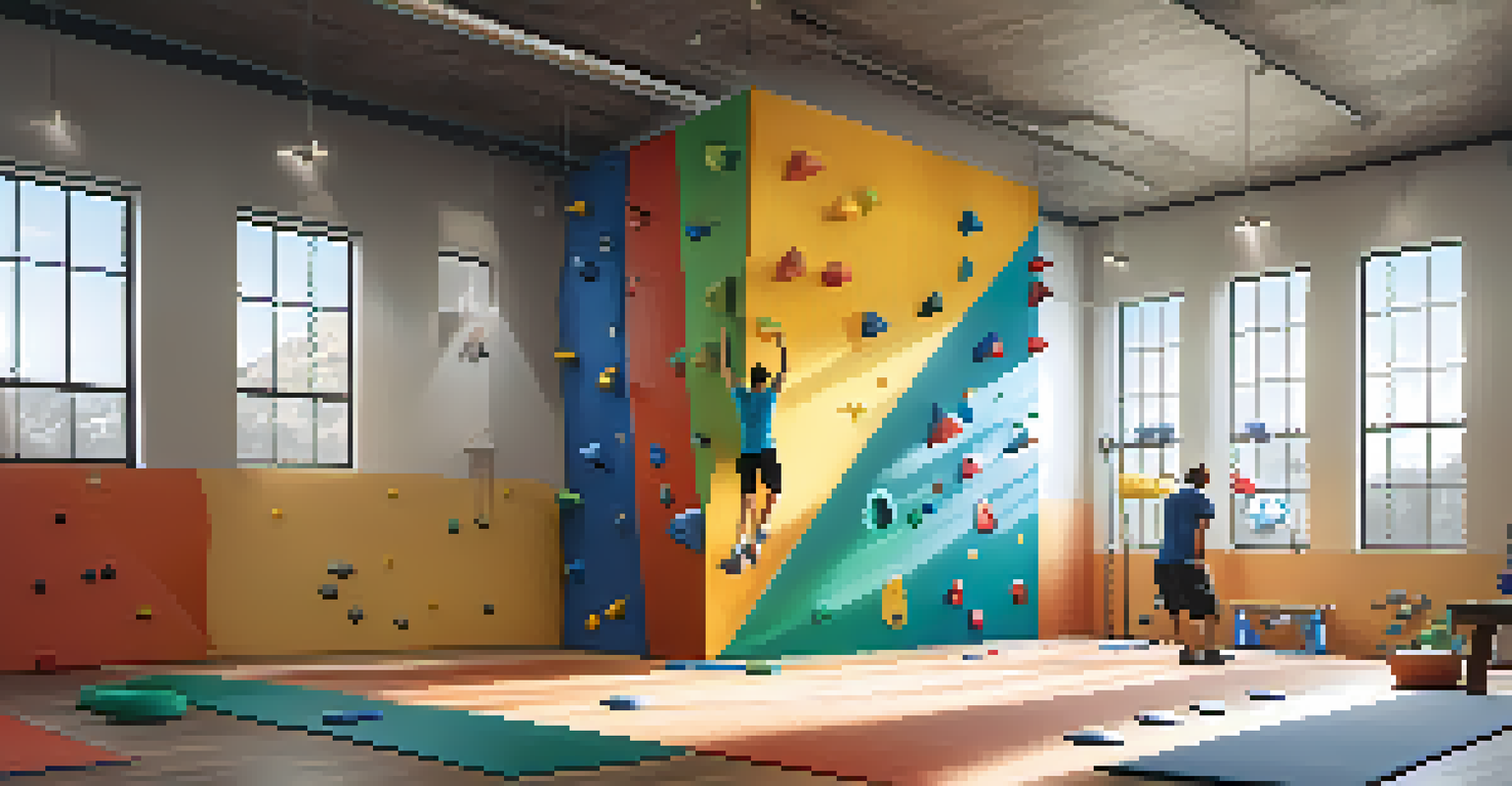Rock Climbing Competitions: What You Need to Know

Understanding the Basics of Rock Climbing Competitions
Rock climbing competitions bring together athletes of all skill levels to showcase their talents. These events can range from local contests to international championships, each with its own unique atmosphere. Generally, competitors are judged based on their climbing speed, technique, and overall performance on set routes or boulders.
The best climber in the world is not necessarily the one who climbs the fastest, but the one who climbs the most intelligently.
There are three primary disciplines in competitive climbing: bouldering, lead climbing, and speed climbing. Bouldering focuses on shorter, more difficult climbs without ropes, while lead climbing involves ascending taller routes with safety gear. Speed climbing is all about who can reach the top the fastest, creating an exciting, head-to-head race.
Each discipline has specific rules and formats, making it essential for competitors to familiarize themselves with the guidelines before entering. This ensures a fair competition where everyone has a clear understanding of expectations and scoring.
How Competitions Are Structured and Scored
Competitions typically begin with a qualification round, where climbers attempt to complete designated routes within a set time. The best performers advance to the finals, where they compete for top honors. Scoring can vary by discipline, but often relies on factors such as completion of routes and time taken.

In bouldering, climbers are scored based on the number of problems they complete and the attempts it took to do so. This means strategy plays a significant role—climbers need to balance taking risks with conserving energy. Conversely, lead climbing scores prioritize the highest point reached on a route, with falls resulting in a lower score.
Key Disciplines in Climbing Competitions
Competitions feature bouldering, lead climbing, and speed climbing, each requiring different strategies and skills.
Understanding these scoring systems is crucial for any competitor, as it helps in formulating a strategy for success. Being aware of the nuances can provide a competitive edge, especially in tightly contested events.
Essential Gear for Competing in Climbing Events
Having the right gear is vital for climbing competitions, as it directly impacts performance and safety. Essential items include climbing shoes, chalk, harnesses, and, in certain cases, ropes. Investing in high-quality equipment tailored to your climbing style can make a noticeable difference on competition day.
Climbing is not the summit of a mountain, but the summit of your abilities, and your aspirations.
Climbing shoes, for example, should fit snugly to allow for precision foot placements on challenging routes. Chalk helps to keep your hands dry, improving your grip and overall control. It's worth noting that some competitions may have specific gear requirements, so checking the regulations beforehand is always a good idea.
Additionally, many climbers find that wearing comfortable, flexible clothing enhances their range of motion. This can be particularly important during intense competitions where every movement counts, allowing climbers to focus on their performance rather than discomfort.
Mental Preparation: Staying Focused and Calm
Mental fortitude is just as crucial as physical ability in rock climbing competitions. Athletes often face intense pressure, which can lead to anxiety and performance issues. Developing mental strategies, such as visualization techniques and breathing exercises, can significantly enhance focus and calmness during events.
Visualization involves mentally rehearsing the climb before stepping onto the wall, allowing climbers to mentally map out their movements. This can help reduce nerves and build confidence, turning anxiety into a powerful motivator. Additionally, deep breathing exercises can help regulate heart rates and maintain composure under pressure.
Mental Preparation is Crucial
Climbers can enhance performance by developing mental strategies, such as visualization and breathing exercises, to manage competition anxiety.
Competitors who prioritize mental preparation often find themselves performing better than those who solely focus on physical training. By developing a balanced approach, climbers can excel both on and off the wall.
The Importance of Community and Networking in Climbing
Rock climbing competitions foster a strong sense of community among participants. Many climbers find camaraderie and encouragement from fellow competitors, which can make the experience even more rewarding. This supportive environment is essential for personal growth and motivation in the climbing world.
Networking at competitions can also open doors to new opportunities, such as sponsorships, coaching, and training partnerships. Engaging with experienced climbers and industry professionals can provide valuable insights into improving skills and navigating the competitive landscape. Building relationships within the climbing community can lead to lifelong friendships and collaborations.
Moreover, this sense of belonging can enhance the overall competition experience. Sharing successes and challenges with like-minded individuals creates a supportive atmosphere that encourages everyone to push their limits.
Training Tips to Prepare for Competing
Training for climbing competitions requires a well-rounded approach, combining strength, technique, and endurance. Developing a structured training plan can help climbers maximize their potential and prepare effectively for competition. This often includes climbing-specific workouts, strength training, and flexibility exercises.
Incorporating variety into training routines is crucial. Climbers should focus not only on their weaknesses but also continue to hone their strengths. For example, if bouldering is your focus, practicing on different types of problems can enhance adaptability and problem-solving skills.
Community Builds Climbing Success
Engaging with the climbing community fosters support, opportunities, and friendships that enhance the competition experience.
Additionally, seeking guidance from coaches or experienced climbers can provide tailored advice to improve technique and performance. Regularly reassessing goals and progress can keep training fresh and exciting, ultimately leading to better results in competitions.
Post-Competition: Reflection and Growth
After a competition, it's essential to take time to reflect on your performance. This reflection can help identify areas for improvement and celebrate successes, no matter how small. Journaling experiences and feelings can provide valuable insights, helping climbers grow both mentally and physically.
Analyzing competition footage, if available, can also aid in understanding what worked well and what didn't. This can provide concrete evidence to support adjustments in training or strategy for future events. Emphasizing growth over perfection allows climbers to maintain a healthy perspective on their journey.

Finally, staying connected with the climbing community can provide continued support and motivation. Whether it's joining training groups or participating in local events, engaging with others can keep the passion for climbing alive and inspire further progress.